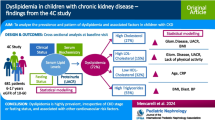Abstract
Purpose
Serum levels of amylase and lipase are frequently increased in patients with chronic kidney disease (CKD). Relatively low serum pancreatic enzyme levels in CKD may represent a state of pancreatic insufficiency and may contribute to protein-energy wasting (PEW). We aimed to investigate the relationships of serum pancreatic enzyme levels with PEW, inflammation, and mortality in CKD patients.
Methods
Two hundred and thirty CKD patients (male/female: 144/86; mean age, 59 ± 16 years) were enrolled. Serum total α-amylase and lipase activities were measured by enzymatic colorimetric assays. Mean follow-up time was 18 ± 10 months. Forty-seven patients (20 %) died during this period.
Results
Serum amylase levels were increased in 95 patients (41 %) and serum lipase levels were increased in 71 patients (30 %) out of the 230 patients. Diabetic patients had significantly lower serum amylase levels than non-diabetic ones (86 ± 46 vs. 111 ± 60 IU/L, p < 0.0001). Patients with ischemic heart disease also had significantly lower serum amylase (82 ± 37 vs. 108 ± 60 IU/L, p < 0.0001) and lipase levels (39 ± 36 vs. 57 ± 57 IU/L, p = 0.007). Serum amylase and lipase levels were directly correlated with serum creatinine (r = 0.173, p = 0.009 and r = 0.374, p < 0.0001) and albumin (r = 0.410, p < 0.0001 and 0.287, p < 0.0001), and inversely correlated with CRP (r = −0.223, p = 0.001 and r = −0.147, p = 0.027). The Kaplan–Meier analysis revealed survival advantages for both high-amylase and high-lipase groups in end-stage renal disease (ESRD) (CKD stage 5) patients (log rank, p < 0.001 and p = 0.02, respectively). In the Cox regression analysis, serum amylase was found to be an independent predictor for mortality.
Conclusion
Serum amylase activity was found to be an independent predictor of mortality in ESRD patients. Relatively low serum pancreatic enzyme levels in CKD may be regarded as a novel component of the malnutrition–inflammation–atherosclerosis syndrome.





Similar content being viewed by others
References
Chen YH, Yang WC, Wang FM, et al (2011) Risk factors associated with elevated serum pancreatic amylase levels during hemodialysis. Hemodial Int 15:79–86
Bastani B, Mifflin TE, Lovell MA, Westervelt FB, Bruns DE (1987) Serum amylases in chronic and end-stage renal failure: effects of mode of therapy, race, diabetes and peritonitis. Am J Nephrol 7(4):292–299
Malmstrøm ML, Hansen MB, Andersen AM (2012) Cytokines and organ failure in acute pancreatitis: inflammatory response in acute pancreatitis. Pancreas 41:271–277
Sachs EF, Hurwitz FJ, Bloch HM, Milne FJ (1983) Pancreatic exocrine hypofunction in the wasting syndrome of end-stage renal disease. Am J Gastroenterol 78(3):170–173
Fouque D, Kalantar-Zadeh K, Kopple J et al (2008) A proposed nomenclature and diagnostic criteria for protein-energy wasting in acute and chronic kidney disease. Kidney Int 73(4):391–398
Vannini FD, Antunes AA, Caramori JC, Martin LC, Barretti P (2009) Associations between nutritional markers and inflammation in hemodialysis patients. Int Urol Nephrol 41(4):1003–1009
Li ZJ, An X, Mao HP, Wei X, Chen JH, Yang X, Zhou SF, Li ZB, Yu XQ (2011) Association between depression and malnutrition-inflammation complex syndrome in patients with continuous ambulatory peritoneal dialysis. Int Urol Nephrol 43(3):875–882
Ujszaszi A, Czira ME, Fornadi K, Novak M, Mucsi I, Molnar MZ (2012) Quality of life and protein-energy wasting in kidney transplant recipients. Int Urol Nephrol Jan 14.(Epub ahead of print)
Pieper-Bigelow C, Strocchi A, Levitt MD (1990) Where does serum amylase come from and where does it go? Gastroenterol Clin North Am 19(4):793–810
Thierry FX, Dueymes JM, Vernier I et al (1988) Serum lipase and amylase levels in chronic renal failure: interpretation of results-effects of extrarenal purification. Nephrologie 9(6):263–267
Manes G, Ricci E, Rabitti PG et al (1994) Serum pancreatic enzymes in patients with chronic renal failure on hemodialysis and in transplant patients. Minerva Gastroenterol Dietol 40(3):113–117
Ventrucci M, Campieri C, Di Stefano M et al (1995) Alterations of exocrine pancreas in end-stage renal disease. Do they reflect a clinically relevant uremic pancreopathy? Dig Dis Sci 40(12):2576–2581
Caruana RJ, Altman R, Fowler B, Blansit B, Chaudhary BA, Weinstein RS (1988) Correlates of amylase and lipase levels in chronic dialysis patients. Int J Artif Organs 11(6):454–458
Araki T, Ueda M, Ogawa K, Tsuji T (1992) Histological pancreatitis in end-stage renal disease. Int J Pancreatol 12(3):263–269
Lerch MM, Hoppe-Seyler P, Gerok W (1994) Origin and development of exocrine pancreatic insufficiency in experimental renal failure. Gut 35(3):401–407
Dandona P, Freedman DB, Foo Y et al (1984) Exocrine pancreatic function in diabetes mellitus. J Clin Pathol 37:302–306
Swislocki A, Noth R, Hallstone A, Kyger E, Triadafilopoulos G (2005) Secretin stimulated amylase release into blood is impaired in type 1 diabetes mellitus. Horm Metab Res 37:326–330
Nakajima K, Nemoto T, Muneyuki T, Kakei M, Fuchigami H, Munakata H (2011) Low serum amylase in association with metabolic syndrome and diabetes: a community-based study. Cardiovasc Diabetol 17(10):34
Conflict of interest
None.
Author information
Authors and Affiliations
Corresponding author
Rights and permissions
About this article
Cite this article
Ozkok, A., Elcioglu, O.C., Cukadar, T. et al. Low serum pancreatic enzyme levels predict mortality and are associated with malnutrition–inflammation–atherosclerosis syndrome in patients with chronic kidney disease. Int Urol Nephrol 45, 477–484 (2013). https://doi.org/10.1007/s11255-012-0237-6
Received:
Accepted:
Published:
Issue Date:
DOI: https://doi.org/10.1007/s11255-012-0237-6




